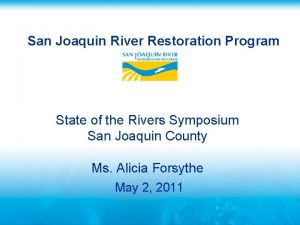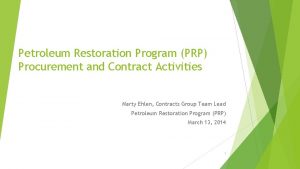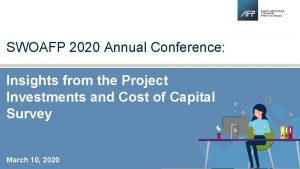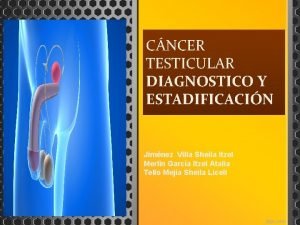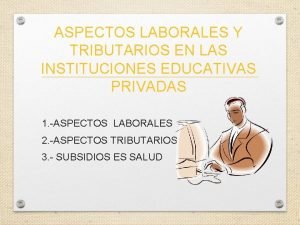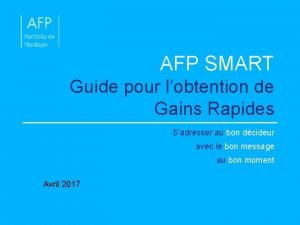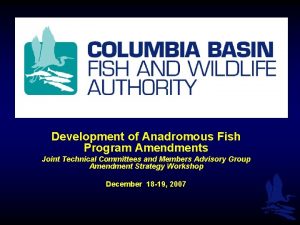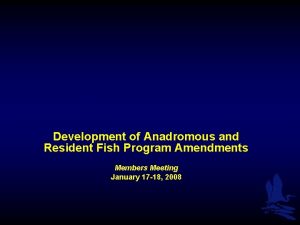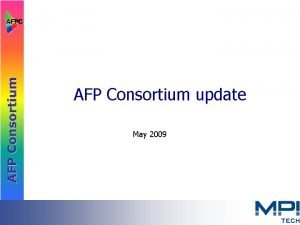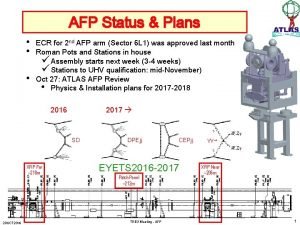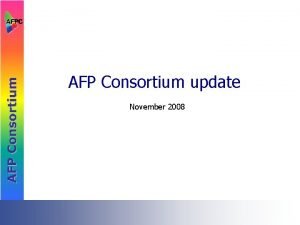Anadromous Fish Program AFP Restoration Strategy Developed at











- Slides: 11

Anadromous Fish Program (AFP) Restoration Strategy • Developed at a coarse-resolution scale – Chinook and O. mykiss only • Scale of the National Marine Fisheries Service’s diversity groups • Meet with regional watershed experts to develop 10 -year candidate strategies • NOT SIT priority recommendations • Discussions will be aided with the modeling and visual tools developed by the SIT

Anadromous Fish Program (AFP) Restoration Strategy • SIT will develop 5 -year management strategy scenarios • Discussions aided with 10 -year candidate strategies developed by regional watershed experts • SIT will compile a set of recommended priorities • Scenarios will be modeled using the SIT DSMs and evaluated and ranked based on the fundamental objectives • Sensitivity analyses will be performed to identify key uncertainties • Highlight monitoring data needs • Across taxa/run results • SIT recommendations will include: • Priority management actions • A process to evaluate implemented management actions • Essential monitoring efforts

Anadromous Fish Program (AFP) Restoration Strategy • Priority management action recommendations • Incorporate a set of location-specific (coarse scale), quantifiable management actions and the sequence of management actions (if applicable) • The process by which the SIT arrived at these management action recommendations • Addendum (if necessary) that includes disagreements/rebuttals by specific members of the SIT for any of the recommended priorities • A process to evaluate implemented management actions • BACI (or other) monitoring design • Project-specific monitoring efforts are focused on quantifying the fundamental objectives • Integrate monitoring, management, and modeling to facilitate learning (i. e. , adaptive management) • Essential monitoring efforts • Essential data to the prioritization process • SIT monitoring data sheet

Anadromous Fish Program (AFP) Restoration Strategy What’s next? • Continued involvement and support from the SIT will be essential to the success of the program • SIT will continue to meet • Update meetings • Schedule depends on the need for feedback from the SIT, but probably quarterly or semiannually • Review progress on requested refinements to DSM inputs and rulesets. • Annual meeting • Review: • • • 5 -year priorities Monitoring results DSM improvements Results from new DSM simulations and sensitivity analyses Any recent information (i. e. , publications, reports, etc. ) relevant to the SIT activities • Grade the state of the DSMs and inputs • Request refinements to the DSM inputs and rulesets via the established SIT proposal process • Make recommendations for modifications to the AFP Restoration Strategy priorities, if necessary

Anadromous Fish Program (AFP) Restoration Strategy What’s next? • Annual process will be documented in an annual technical memorandum that will be attached to the AFP Restoration Strategy as an additional addendum • Year 4 in the 5 -year process • Comprehensive review of DSMs and monitoring data • Science Coordinator will be tasked with conducting the review and recruiting outside experts to aid in the review • Results of the review will be made available to the SIT and Core Team • Science Coordinator will meet with regional watershed experts to identify changes (if any) from the previously identified regionspecific 10 -year candidate strategies

Where are we? • Chinook efforts • Fall run • Reviewed DSM • Identified and made changes • Spring and winter run Chinook • Developed conceptual models • Resulted in minor differences from the new fall run DSM structure • DSM inputs are currently being collated • Need these data to recalibrate DSMs and integrate into single Chinook DSM • Refining fundamental objectives • Fundamental objectives now 5 instead of 18 • No agreement on what juvenile metric to use • Need to recalibrate DSMs • Refining decision alternatives (scenarios) • Unit of effort • Developing new pulse flow scenarios • Developed a Bayesian integrated model • Links escapement estimates to juvenile screw-trap monitoring data • Derive empirical estimates of juvenile survival, growth, and movement transition probabilities • Simulations are currently underway to evaluate model performance

Where are we? • O. mykiss efforts • Identified objectives • Created decision alternatives • Developing a quantitative DSM • • Conceptual model was developed Model components have been built Recently received feedback on DSM rulesets Linking model components to form DSM • Sturgeon efforts • • Identified objectives Created decision alternatives Developed conceptual models Created and distributed score sheet

Benchmarks to realize the AFP Restoration Strategy by August 1, 2019 January – April 2018 • Chinook: • • Finalize Chinook management scenarios and objective metrics Collate DSM inputs Fit integrated model to screw-trap data, escapement estimates, and DSM inputs Calibrate and evaluate the performance of DSMs Integrate the 3 Chinook DSMs into a single DSM Identify Chinook priorities Grade DSM performance and identify needed refinements • O. mykiss: • • • Refine management scenarios and objectives Complete modifications to DSM Collate DSM inputs Calibrate and evaluate the performance of DSM Identify O. mykiss priorities Grade DSM performance and identify needed refinements • Sturgeon: • Identify priorities using score sheet

Benchmarks to realize the AFP Restoration Strategy by August 1, 2019 May – August 2018 • Chinook and O. mykiss: • • • Meet with regional watershed experts to identify 10 -year candidate strategies Document expert 10 -year candidate strategies and disperse to SIT develops candidate 5 -year strategy scenarios Complete any requested DSM and DSM input refinements Compile DSM inputs • Sturgeon: • • Refine objectives Refine management scenarios Develop DSM Compile DSM inputs

Benchmarks to realize the AFP Restoration Strategy by August 1, 2019 September – December 2018 • Chinook and O. mykiss: • SIT develop 5 -year management strategies (continued, if needed) • Complete hindcasting of Chinook to reduce DSM uncertainties (if data become available) • Calibrate DSMs • Integrate O. mykiss DSM with Chinook DSM • Simulate candidate 5 -year management strategies • Conduct sensitivity analyses to identify key DSM uncertainties • Sturgeon: • • Refine DSM Calibrate DSM (depending on fish data availability) Simulate management strategies Conduct sensitivity analyses to identify key DSM uncertainties

Benchmarks to realize the AFP Restoration Strategy by August 1, 2019 January – April 2019 • Chinook and O. mykiss: • Rank priorities • Complete the first draft of the AFP Restoration Strategy • Send draft AFP Restoration Strategy out for comments • Sturgeon: • Rank priorities • Complete the first draft of the sturgeon technical memorandum • Send draft technical memorandum out for comments May – July 2019 • All species • Review comments on AFP Restoration Strategy and Sturgeon Technical Memorandum • Modify documents as necessary • Release final draft of the documents




